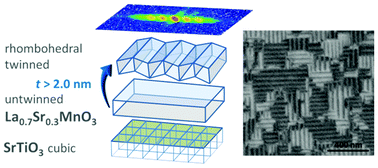Thickness evolution of the twin structure and shear strain in LSMO films
Abstract

* Corresponding authors
a
Research Centre for Nanoscience and Nanotechnology, CIN2 (CSIC-ICN), Campus UAB, 08193 Bellaterra, Catalonia, Spain
E-mail:
jsantiso@cin2.es
Tel: +34 93 7373634
b
Institut de Ciència de Materials de Barcelona, CSIC, Campus de la Universitat Autònoma de Barcelona, 08193 Bellaterra, Catalonia, Spain
E-mail:
felip@icmab.es
Tel: +34 93 5801853
c
SpLine (BM25), ESRF, Grenoble, France
E-mail:
p.ferrer-escorihuela@diamond.ac.uk
d Instituto de Ciencia de Materiales de Madrid ICMM-CSIC, Madrid, Spain

 Please wait while we load your content...
Something went wrong. Try again?
Please wait while we load your content...
Something went wrong. Try again?
J. Santiso, L. Balcells, Z. Konstantinovic, J. Roqueta, P. Ferrer, A. Pomar, B. Martínez and F. Sandiumenge, CrystEngComm, 2013, 15, 3908 DOI: 10.1039/C3CE40085A
To request permission to reproduce material from this article, please go to the Copyright Clearance Center request page.
If you are an author contributing to an RSC publication, you do not need to request permission provided correct acknowledgement is given.
If you are the author of this article, you do not need to request permission to reproduce figures and diagrams provided correct acknowledgement is given. If you want to reproduce the whole article in a third-party publication (excluding your thesis/dissertation for which permission is not required) please go to the Copyright Clearance Center request page.
Read more about how to correctly acknowledge RSC content.
 Fetching data from CrossRef.
Fetching data from CrossRef.
This may take some time to load.
Loading related content
